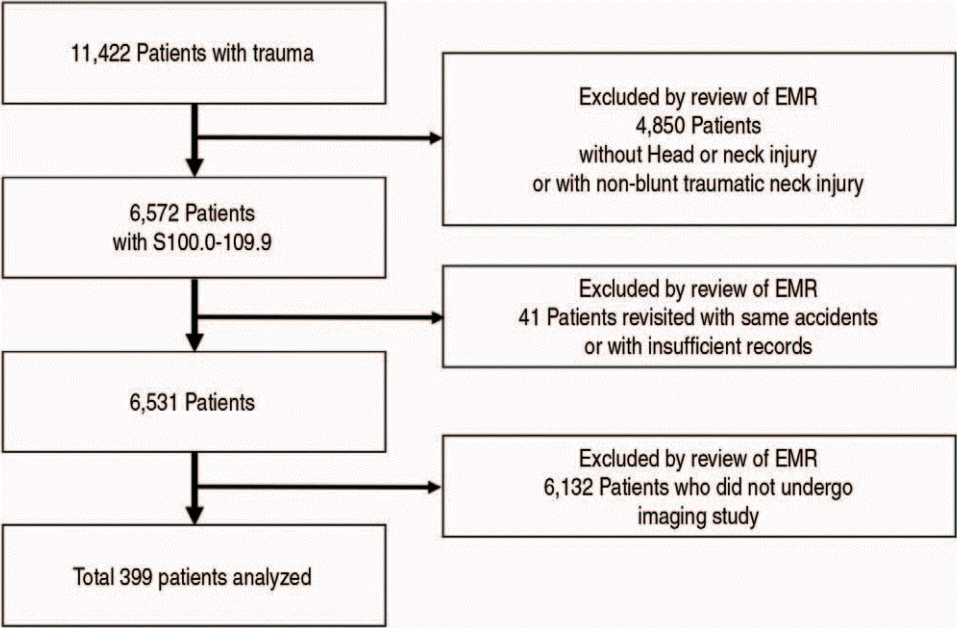2. Shavelle RM, Devivo MJ, Paculdo DR, Vogel LC, Strauss DJ. Long-term survival after childhood spinal cord injury. J Spinal Cord Med. 2007; 30 Suppl 1:S48–54.
3. Phillips N, Rasmussen K, McGuire S, Abel KA, Acworth J, Askin G, et al. Projected paediatric cervical spine imaging rates with application of NEXUS, Canadian C-Spine and PECARN clinical decision rules in a prospective Australian cohort. Emerg Med J. 2021; 38:330–7.
4. Mohseni S, Talving P, Branco BC, Chan LS, Lustenberger T, Inaba K, et al. Effect of age on cervical spine injury in pediatric population: a National Trauma Data Bank review. J Pediatr Surg. 2011; 46:1771–6.
5. Viccellio P, Simon H, Pressman BD, Shah MN, Mower WR, Hoffman JR. A prospective multicenter study of cervical spine injury in children. Pediatrics. 2001; 108:E20.
6. Stiell IG, Wells GA, Vandemheen KL, Clement CM, Lesiuk H, De Maio VJ, et al. The Canadian C-spine rule for radiography in alert and stable trauma patients. JAMA. 2001; 286:1841–8.
7. Hoffman JR, Mower WR, Wolfson AB, Todd KH, Zucker MI; National Emergency X-Radiography Utilization Study Group. Validity of a set of clinical criteria to rule out injury to the cervical spine in patients with blunt trauma. N Engl J Med. 2000; 343:94–9.
8. Pieretti-Vanmarcke R, Velmahos GC, Nance ML, Islam S, Falcone RA Jr, Wales PW, et al. Clinical clearance of the cervical spine in blunt trauma patients younger than 3 years: a multi-center study of the american association for the surgery of trauma. J Trauma. 2009; 67:543–50.
9. Burns EC, Yanchar NL. Using cervical spine clearance guidelines in a pediatric population: a survey of physician practices and opinions. CJEM. 2011; 13:1–6.
10. Yoon KW. Failure of initial neurologic assessment for SCIWORA with brain injury in 22-month-old patient. J Korean Soc Emerg Med. 2019; 30:598–602. Korean.
11. Leonard JC, Kuppermann N, Olsen C, Babcock-Cimpello L, Brown K, Mahajan P, et al. Factors associated with cervical spine injury in children after blunt trauma. Ann Emerg Med. 2011; 58:145–55.
12. Ehrlich PF, Wee C, Drongowski R, Rana AR. Canadian Cspine Rule and the National Emergency X-Radiography Utilization low-risk criteria for C-spine radiography in young trauma patients. J Pediatr Surg. 2009; 44:987–91.
13. Leonard JR, Jaffe DM, Kuppermann N, Olsen CS, Leonard JC; Pediatric Emergency Care Applied Research Network (PECARN) Cervical Spine Study Group. Cervical spine injury patterns in children. Pediatrics. 2014; 133:e1179–88.
14. Leonard JC, Browne LR, Ahmad FA, Schwartz H, Wallendorf M, Leonard JR, et al. Cervical spine injury risk factors in children with blunt trauma. Pediatrics. 2019; 144:e20183221.
15. Kim W, Ahn N, Ata A, Adamo MA, Entezami P, Edwards M. Pediatric cervical spine injury in the United States: defining the burden of injury, need for operative intervention, and disparities in imaging across trauma centers. J Pediatr Surg. 2021; 56:293–6.
16. Garton HJ, Hammer MR. Detection of pediatric cervical spine injury. Neurosurgery. 2008; 62:700–8.
17. Cui LW, Probst MA, Hoffman JR, Mower WR. Sensitivity of plain radiography for pediatric cervical spine injury. Emerg Radiol. 2016; 23:443–8.
18. Slaar A, Fockens MM, Wang J, Maas M, Wilson DJ, Goslings JC, et al. Triage tools for detecting cervical spine injury in pediatric trauma patients. Cochrane Database Syst Rev. 2017; 12:CD011686.
19. Leonard JC, Jaffe DM, Olsen CS, Kuppermann N. Age-related differences in factors associated with cervical spine injuries in children. Acad Emerg Med. 2015; 22:441–6.
20. Ferderber JS, Wolfson AB. The dangers of spear tackling: a case report of a NEXUS-negative high school football player. J Emerg Med. 2019; 56:185–90.
21. Gopinathan NR, Viswanathan VK, Crawford AH. Cervical spine evaluation in pediatric trauma: a review and an update of current concepts. Indian J Orthop. 2018; 52:489–500.




 PDF
PDF Citation
Citation Print
Print




 XML Download
XML Download